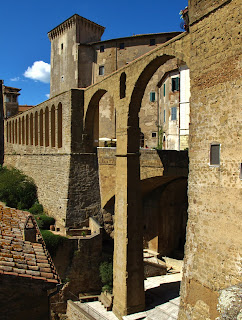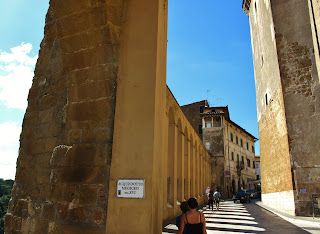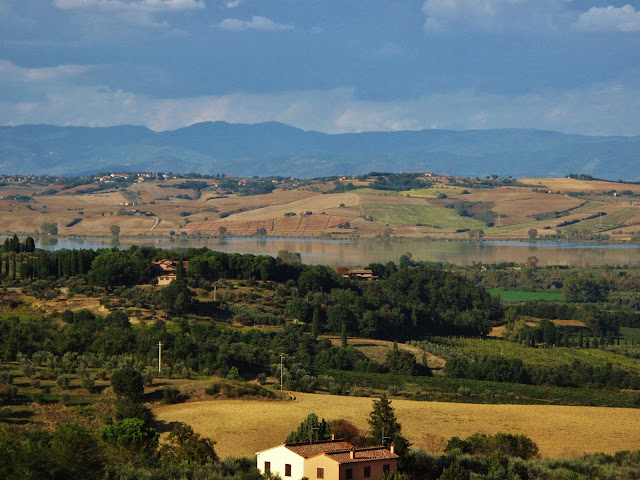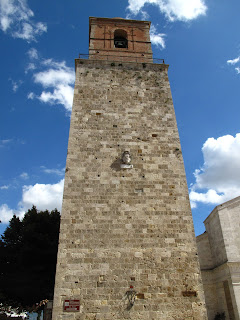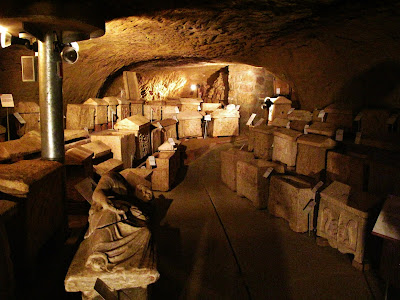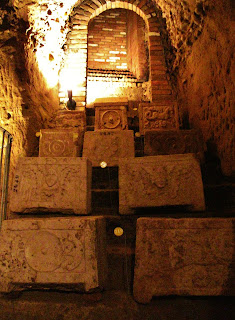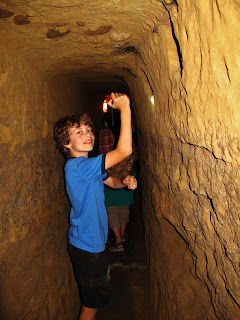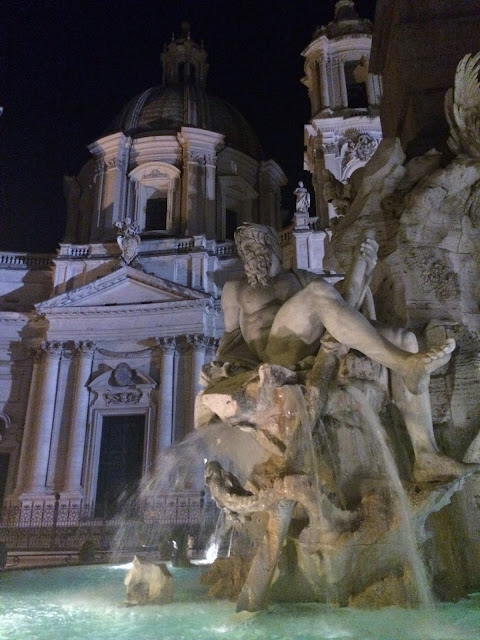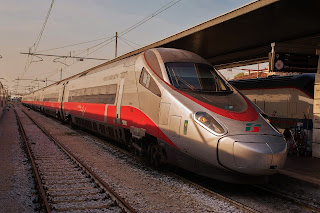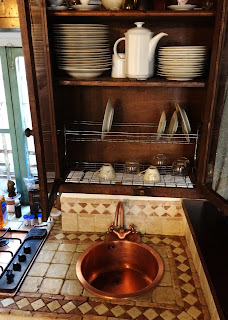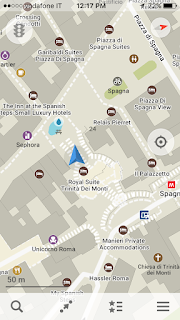Pitigliano in Southern Tuscany is not perched upon the tufa rock, it IS the tufa rock! Carved from Tufaceous or volcanic rock, the village of Pitigliano is part of the area of towns that make up the "Borghi del Tufo"...
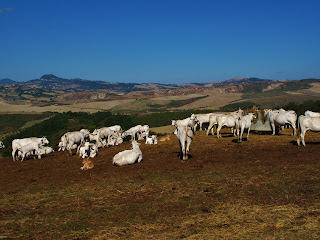
Heading from out from Cortona, which had been our home base for the past week, we drive further south through Southern Tuscany to the province of Grossetto. Grosetto is known for its beautiful beaches, Chianina cattle and cowboys. Grossetto also is home to excellent thermal springs and some off-the-beaten-path hill towns. Three of these spectacular hill towns are in the Fiora River Valley; Sovana, Sorano and Pitigliano.
Driving to Pitigliano is half the adventure! Taking the local roads, we traversed mountains, drove down cypress-lined lanes and through cattle ranches dotted with white Chianina cows.
 |
| Pitigliano From The View Point |
The countryside of Southern Tuscany in late September was the colour of gold, and the forests were random patches of dark
green, creating a patchwork effect. We drove small roads winding up the
rounded mountains and then riding the ridge for a few moments before suddenly plunging down the
other side again. Forests of Oak and Maple with little vineyards and pastures
cut into the mountainside dotted with castles and church spires
off in the distance.
If you are driving from Rome to Pitigliano, you most likely arrive via the SR74, which cuts through the modern part of Pitigliano. The road makes a sudden hairpin turn, and there is a scenic viewpoint along Via San Michele that has free public parking.

Pitigliano was founded by the Etruscans in the 7th-6th century BCE, but little is know of its ancient past. Historians believe the city may have been wiped out by the Etruscan King of Chiusi, Lars Porsenna, in 500 BCE. The tufa rock outcropping in the middle of a vast canyon is a natural form of defence, which is a typical Etruscan building strategy. The outcropping that the city sits upon used to be connected by a footbridge.
Nowadays, there is a street that bridges the canyon, and the entrance to the city is through the medieval wall to the 14th century Orsini fortress. The fortified palace now holds the Civic Archaeological Museum and the Museum of Holy Art.€3 entry fee for each.
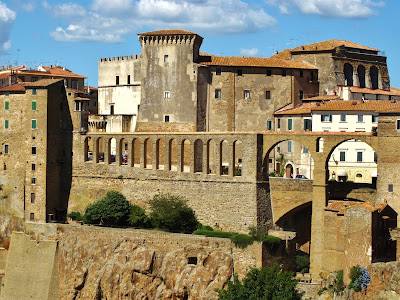
Once past the Palace complex, you are on Via Cavour, and the impressive Medicean Aquaduct appears on your left side. This was built not by the Romans but in 1639 by the Medici Family, who ruled Pitigliano after the Orsini.
Following Via Cavour between the aqueduct and the fortress, you arrive at Piazza Republica, an elegant Renaissance square that's fountain frames the forested canyon below.

Once past Piazza Republica Via Cavour turns into Via Roma, the main Corso, which forms an oval-shaped circuit through town. Pitigliano transforms from an elegant Renaissance hill town into a medieval maze of staircases, underpasses and narrow alleyways. Following Via Roma, you arrive at Piazza San Giorgio and the Baroque Cathedral of St Peter and Paul. It was actually built in 1061 but given a facelift in the 18th century by one of the Orsini family. The 35-foot belltower standing next to the church looks awkwardly underdressed!

Further along the street, the road changes name again to Via Generale Orsini, and we come to San Rocco, Pitigliano's oldest church. Constructed in the 12th-13th century, the church is worth popping inside. The centuries worth of rulers' coat of arms are on display behind the altar, and beautiful frescos and paintings adorn this romantic church. There is a little side chapel to Saint Apollonia (the patron Saint of dentistry) complete with a portrait of a bucktooth woman in medieval garb holding a big pair of pliers and a bloody tooth. My son thought it was the Italian Tooth Fairy!


Once past the church of San Rocco, the street changes name again and becomes Via Aldobrandeschi. This is the oldest part of Pitigliano with many medieval buildings and streets. Follow the road to the end, and you will find a viewpoint with stunning views of the valley below.
A little laneway on the right called Via Porta di Sovana takes you down an alleyway to the mysterious Via Cava. The Vie Cave are hand-cut trenches that became an interconnected road network between Sovana, Sorano and Pitigliano. Nobody knows for sure what their real function was, but they date back to the early Etruscan era. If you have time for a leisurely walk, I recommend exploring the Vie Cave.


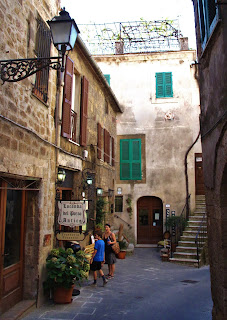
Eating in Pitigliano is a treat! Of course, just like every Italian hill town, there is a regional specialty. We ate at the Locanda del Pozzo Antico, which is a family-run trattoria and pizzeria. Ravioli stuffed with sheep milk cheese is a specialty here, and the Pitigliano white wine Bianco di Pitigliano made from Trebbiano Toscano grapes is a crisp and fruity treat! Red wine drinkers should be on the lookout for Sovana DOC wines made in the closeby region of the hill town of Sovana. Just be aware that the pizza ovens do not fire up until the evenings in Pitigliano. If you are craving a sweet treat after your meal, try the local cookies called sfratti made from walnuts, honey, nutmeg and orange peel all wrapped up in a delicious dough. A great place to pick up sfratti is at Panifico del Ghetto (167 Via Zuccarelli) near the synagogue.
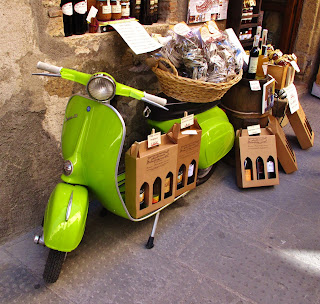 Pitigliano is known as Tuscany's Little Jerusalem. From 1555 to 1569, the Pope issued a papal bull that evicted all Jews from the Holy Lands. Crossing the border from Lazio into Tuscany, many Jewish people made Pitigliano their home when fleeing the State of the Church. By 1600 Jewish people settled into the Borghi di Tuffo; Sorano, Sovana and Pitigliano being confined to live only in the ghettos provided. The peaceful coexistence of the Jewish people in Pitigliano resulted in a synagogue being built in the Jewish quarter of Pitigliano. This synagogue is still the only one in existence in the Grosetto Province of Tuscany. A walk in the Jewish quarter along Via Zuccarelle is an evocative peek into Jewish life 400 years ago. For more tourist information on Pitigliano, go to pitigliano.org.
Pitigliano is known as Tuscany's Little Jerusalem. From 1555 to 1569, the Pope issued a papal bull that evicted all Jews from the Holy Lands. Crossing the border from Lazio into Tuscany, many Jewish people made Pitigliano their home when fleeing the State of the Church. By 1600 Jewish people settled into the Borghi di Tuffo; Sorano, Sovana and Pitigliano being confined to live only in the ghettos provided. The peaceful coexistence of the Jewish people in Pitigliano resulted in a synagogue being built in the Jewish quarter of Pitigliano. This synagogue is still the only one in existence in the Grosetto Province of Tuscany. A walk in the Jewish quarter along Via Zuccarelle is an evocative peek into Jewish life 400 years ago. For more tourist information on Pitigliano, go to pitigliano.org.
Pitigliano is a romantic town to
explore. The history, the culture, the mystery ... and you must see it lit up at night!

